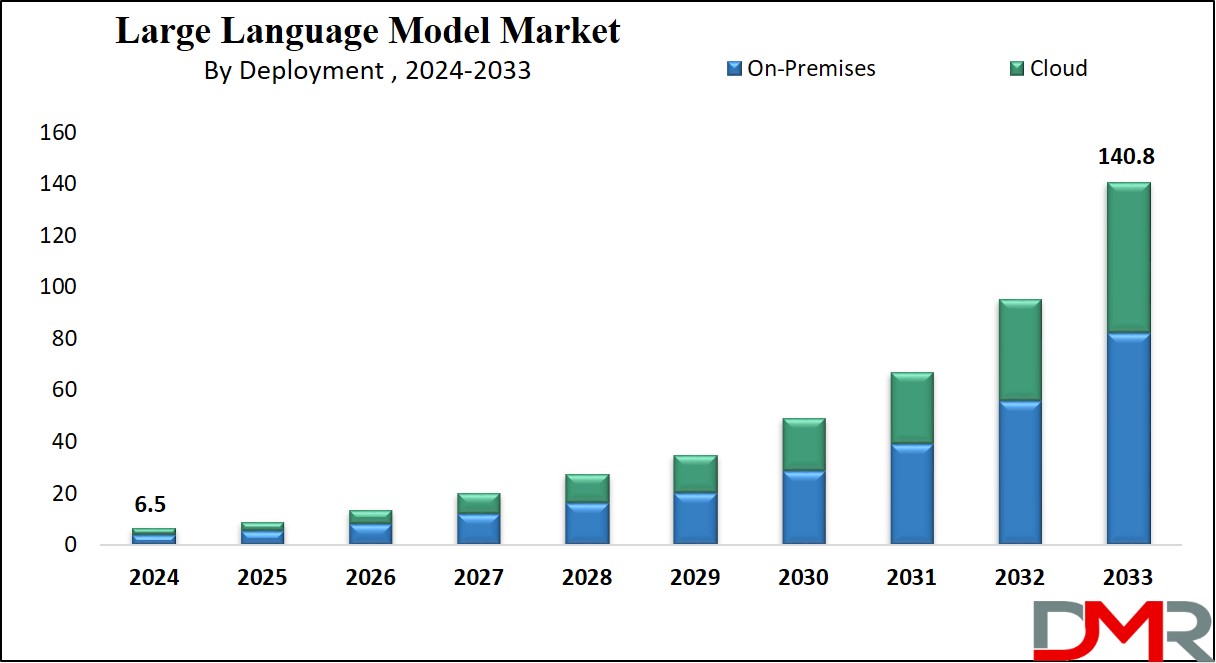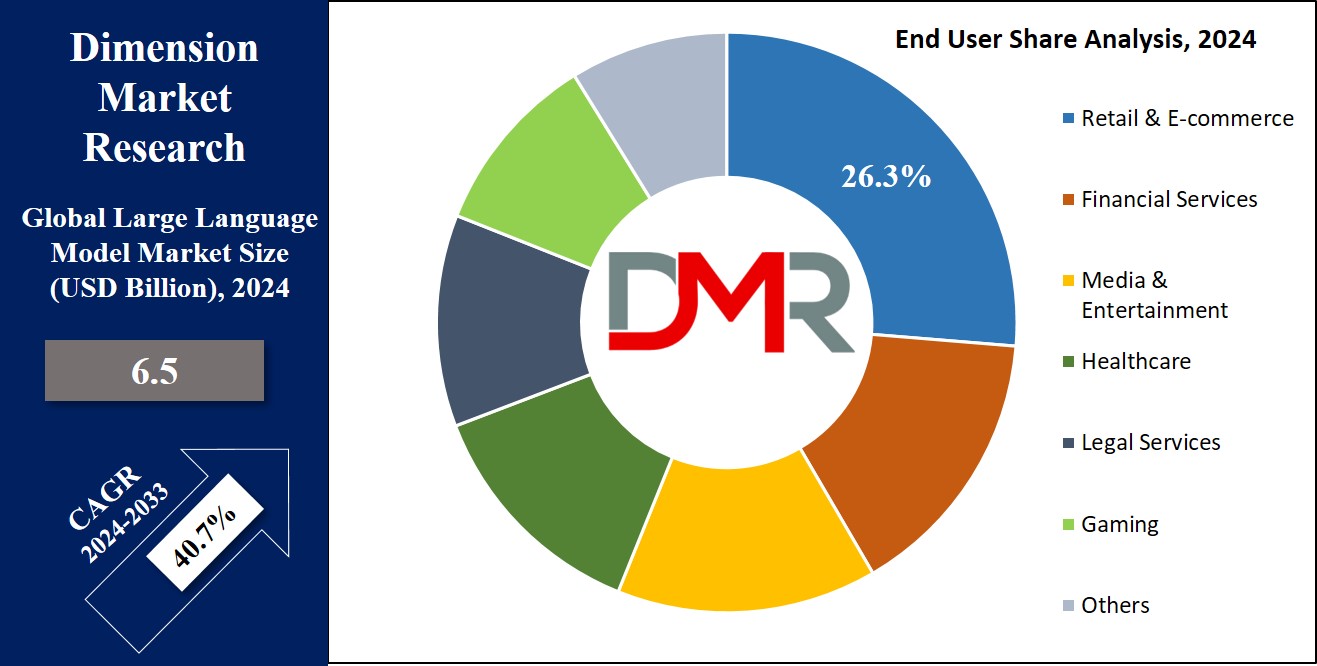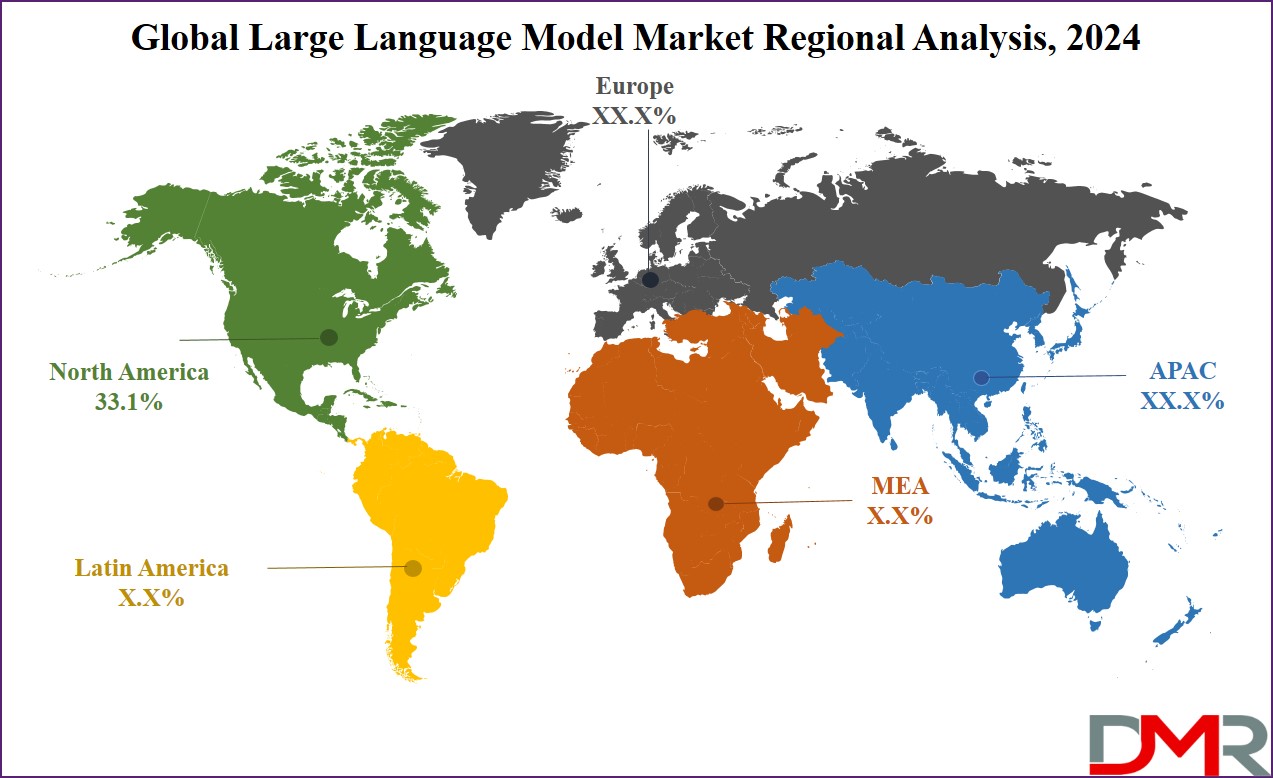Market Overview
The Global Large Language Model Market is expected to grow at a CAGR of 40.7% by attaining a value of USD 6.5 billion by the end of 2024, which is further projected to reach a value of USD 140.8 billion by 2033.
A Large Language Model also known as LLM is a form of deep learning algorithm, which is used to perform numerous tasks based on Natural Language Processing (NLP). Further, these models use transformer models and are trained using large datasets, which allows them to recognize, translate, and predict/generate text or other content.

Additionally, apart from teaching AI about human languages, LLM can also be trained to perform numerous tasks like understanding protein structures, writing software code, and more. Also, just like the human brain, these LLMs need to be pre-trained and fine-tuned to solve text classification, documentation summarization, question answering, and more.
Scalability can be achieved with advanced technologies by integrating large language models (LLMs). Databricks, Inc. a U.S. software company recently made headlines for their acquisition of MosaicML for $1.3 billion - an expert in large language models and model training software specializing in large language models in June 2023 for $1.3 billion. MosaicML's expertise lies within model development, training and inference will enhance Databricks lakehouse platform and allow businesses to create robust AI apps driving innovation across industries.
Key Takeaways
- By Deployment, On-premises segment will lead the market in 2024 & is anticipated to dominate throughout the forecasted period.
- In addition, Cloud segment is expected to have significant growth over the forecasted period.
- By Application, Chatbots & virtual assistant are expected to take the lead & drives the market in 2024
- By End Users, the retail & e-commerce sector is expected to dominate the market throughout the forecasted period.
- North America has a 33.1% share of revenue in the Global Large Language Model Market in 2024.
- Some of the use cases of LLM include supply chain management, search, answering questions and more.
Use Cases: Large Language Model
- Supply Chain Management: LLMs are used to transform supply chain management by providing more predictability & control over supply & demand. Further, procurement teams highly depend on generative AI to choose vendors, analyze financial data & look into supplier performance.
- Answering Questions: LLMs can be used in many places to provide question-answering systems like in customer services, healthcare, and education. For instance, a chatbot for customer service can use LLMs to understand questions & then answer them accordingly & correctly.
- Search: LLMs are used to enhance the quality of search results by providing users with more relevant & precise information, search engines like Google & Bling use LLMs to provide better user results, they achieve this by understanding the user's search intent & utilizing data to provide the more accurate & direct results.
- LLM use in Social Media: The LLMs are converting content creation & generation processes across the social media market, as it is used for automated article writing, blog & social media post creation workflows and more
Market Dynamic
The growth in the demand for advanced natural language processing (NLP) capabilities across diverse industries drives the market for large language models, as these models, powered by specialized algorithms like GPT-3.5, offer improved communication, content generation, & problem-solving solutions.
Further, businesses use these models for automation, customer support, & data analysis, which drives innovation & efficiency. The market is also driven by the growing awareness of the adaptability of large language models, encouraging investment in R&D to unlock new applications and possibilities.
However, the ethical and privacy concerns surrounding data usage, potential biases in model outputs, and the concentration of power in a few entities, raise questions about responsible AI deployment and governance, which acts as a restraint to the growth of the market.
Research Scope and Analysis
By Type
The global large language model market by type is categorized into Zero-shot Model, Multimodal Model, Language Representation Model, and Pre-trained & Fine-tuned Model. The zero-shot models are the type of LLMs that are known for their ability to execute tasks without any proper training, as they can generalize & make projections or create text for work that's never been done prior.
Also, multimodal models work with each text & image data, as these are designed to understand & generate content across various modalities. Like, OpenAI's Clip is a multimodal model that can link text with images & images with text content, making it useful for tasks like captioning image & text-based image retrieval. All these factors & trends are expected to grow the market in the coming years
By Deployment
The on-premise segment is expected to lead the market in 2024 with the largest revenue share, as on-premise solutions provide more customization options & control over the infrastructure, enabling organizations to customize LLMs to their specific needs & integrate them more smoothly with existing systems.
Further, some organizations, mainly in highly governed industries like finance or healthcare, go for on-premise solutions to retain authority over their data, creating alignment with industry standards. Also, organizations with concerns about the sensitivity of their data may opt for On-premise solutions to maintain direct control over data access & storage, minimizing dependency on external providers.
The cloud segment is anticipated to register the fastest growth over a forecast period, as these solutions offer scalability, enabling businesses to quickly scale their computational resources up or down based on demand, which accommodates varying workloads and changing needs without needing significant infrastructure changes.
Further, these often operate on a pay-as-you-go model, which reduces the requirement for substantial upfront investment, which further allows businesses to optimize expenses, paying only for the resources they use.
By Application
The
chatbots and virtual assistant applications are expected to lead the large language model (LLM) market, securing the largest revenue share in 2024, which excels in conversational interactions, customer service, & task automation, providing accessibility & user-friendliness.
Further, they also deliver quick, personalized responses and enhance user engagement, making them a popular means of customer interaction for businesses. Also, the acceptance of chatbots & virtual assistants,
healthcare virtual assistants has allowed their integration into different systems & customer support channels.
Further, sentiment analysis is expected to grow significantly in the coming years, as large language models are highly effective in sentiment analysis, accurately calculating emotions expressed in text. They analyze & understand the tone of written content, providing valuable insights into people's feelings & opinions, which further drives the growth of the market.
By End User
The retail and e-commerce sector is anticipated to dominate the large language model (LLM) market in 2024, holding the largest revenue share, as LLMs play a critical role in this industry by providing customized shopping experiences & recommendations.
By analyzing customer preferences & behaviors, these models enhance satisfaction, drive advanced search features, and improve product discovery, ultimately leading to higher conversions & enhanced customer retention.

Further, the media & entertainment segment is expected to have rapid growth, which contributes to customized content recommendations, improving user engagement by suggesting tailored movies, shows, articles, or music. Moreover, they also help content creators generate ideas, suggest storylines, and enable innovative storytelling formats, like interactive narratives. In addition, LLMs use language translation & localization, expanding global reach and accessibility to numerous audiences worldwide.
The Large Language Model Market Report is segmented on the basis of the following:
By Type
- Zero-shot Model
- Pre-trained & Fine-tuned Model
- Language Representation Model
- Multimodal Model
By Deployment
By Application
- Chatbots & Virtual Assistant
- Sentiment Analysis
- Language Translation
- Text Generation
- Content Rewriting & Summarization
- Content Personalization
- Code Generation
- Others
By End User
- Retail & E-commerce
- Financial Services
- Media & Entertainment
- Healthcare
- Legal Services
- Gaming
- Others(IT & ITES, Education)
Regional Analysis
North America is expected to lead the large language model
(LLM) market in 2024, with a significant
33.1% revenue share, as known for its tech innovation hubs & premier AI research institutions, the region supports the growth of LLM technology.
Further, industries like tech, healthcare, finance, & entertainment in the region are early adopters, driving the need and supporting its market dominance. Also, the abundance of resources, like computing infrastructure & collaboration opportunities, further enhances North America's leadership.

Moreover, the Asia-Pacific region is expected to experience a major growth. With a variety & growth in digital population, it provides numerous opportunities for LLM adoption across different industries. Furthermore, the emergence of innovative startups & tech companies specializing in AI & NLP is contributing to the region's LLM development, providing unique solutions to the market and shaping its dynamic growth trajectory.
By Region
North America
Europe
- Germany
- The U.K.
- France
- Italy
- Russia
- Spain
- Benelux
- Nordic
- Rest of Europe
Asia-Pacific
- China
- Japan
- South Korea
- India
- ANZ
- ASEAN
- Rest of Asia-Pacific
Latin America
- Brazil
- Mexico
- Argentina
- Colombia
- Rest of Latin America
Middle East & Africa
- Saudi Arabia
- UAE
- South Africa
- Israel
- Egypt
- Rest of MEA
Competitive Landscape
The global large language model market possesses a competitive market with key players competing for market share, as established tech giants & innovative startups are constantly involved in developing & installing advanced language models, these entities compete through constant R&D, strategic collaborations, & a variety of applications across industries.
Further, the market dynamics are shaped by current developments, product diversification, & a race to provide advanced solutions.
Some of the prominent players in the global Large Language Model Market are
- OpenAI LP
- Amazon
- Alibaba Group Holding Ltd
- Google LLC
- Meta
- Baidu
- Tencent
- Naver
- AI21 Labs
- Microsoft Corp
- Huawei
- Other Key Players
Recent Developments
- In April 2023, Stability AI announced that its models are available for developers to use &adapt on GitHub, as it is designed to effectively generate text & code. Further, it’s trained on a major version of the open-source dataset known as the Pile, which includes information from a range of sources, like Wikipedia, Stack Exchange, & PubMed.
- In March 2023, Microsoft-owned OpenAI announced the launch of its new large multimodal model "GPT-4" which accepts image & text inputs. Further, in comparison to GPT-3.5, the new AI model comes out as more reliable, creative, and capable of handling complex instructions. Moreover, the GPT-4 outperforms current large language models (LLMs), like most state-of-the-art (SOTA) models which may include benchmark-specific construction or additional training methods.
- In March 2023, Google launched one of its most advanced AI language models called PaLM, which alongside several AI enterprise tools will help businesses “generate text, images, code, videos, audio, & more from simple natural language prompts. Further, it is a large language model, or LLM, similar to the GPT series created by OpenAI or Meta’s LLaMA family of models.
- In February 2023, Meta announced the launch of a new large language model called LLaMA, which is developed to help scientists & engineers explore applications for AI like answering questions and summarizing documents. Further, it was developed by its Fundamental AI Research (FAIR) team and comes as large tech companies and well-capitalized startups alike race to tout advances in artificial intelligence techniques & integrate the technology into commercial products.
Report Details
| Report Characteristics |
| Market Size (2023) |
USD 6.5 BN |
| Forecast Value (2032) |
USD 140.8 BN |
| CAGR (2023-2032) |
40.7% |
| Historical Data |
2018 – 2023 |
| Forecast Data |
2024 – 2033 |
| Base Year |
2023 |
| Estimate Year |
2024 |
| Report Coverage |
Market Revenue Estimation, Market Dynamics, Competitive Landscape, Growth Factors and etc. |
| Segments Covered |
By Type (Zero-shot Model, Pre-trained & Fine-tuned Model, Language Representation Model, and Multimodal Model), By Deployment (Cloud and On- Premises), By Application (Chatbots & Virtual Assistant, Sentiment Analysis, Language Translation, Text Generation, Content Rewriting & Summarization, Content Personalization, Code Generation, and Others), By End User (Retail & E- commerce, Financial Services, Media & Entertainment, Healthcare, Legal Services, Gaming, and Others) |
| Regional Coverage |
North America – The US and Canada; Europe – Germany, The UK, France, Russia, Spain, Italy, Benelux, Nordic, & Rest of Europe; Asia- Pacific– China, Japan, South Korea, India, ANZ, ASEAN, Rest of APAC; Latin America – Brazil, Mexico, Argentina, Colombia, Rest of Latin America; Middle East & Africa – Saudi Arabia, UAE, South Africa, Turkey, Egypt, Israel, & Rest of MEA |
| Prominent Players |
OpenAI LP, Amazon, Alibaba Group Holding Ltd, Google LLC, Meta, Baidu, Tencent, Naver, AI21 Labs, Microsoft Corp, Huawei, and Other Key Players |
| Purchase Options |
We have three licenses to opt for: Single User License (Limited to 1 user), Multi-User License (Up to 5 Users), and Corporate Use License (Unlimited User) along with free report customization equivalent to 0 analyst working days, 3 analysts working days and 5 analysts working days respectively. |
Frequently Asked Questions
The Global Large Language Model Market size is estimated to have a value of USD 6.5 billion in 2024 and is expected to reach USD 140.8 billion by the end of 2033.
North America is expected to hold the largest market share for the Global Large Language Model Market with a share of about 33.1% in 2024.
Some of the major key players in the Global Large Language Model Market are Open AI, Amazon, Google, and many others.
The market is growing at a CAGR of 40.7 percent over the forecasted period.